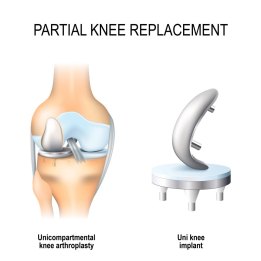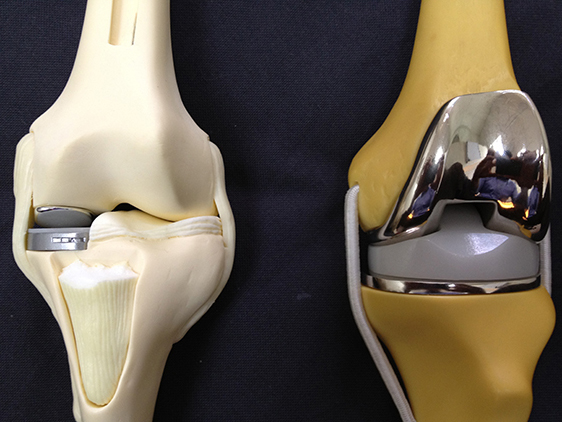At this point we should become concerned about the joints and consider meeting your orthopaedic surgeon for a complete evaluation.
Usually as age progresses, people start experiencing pain and stiffness in their knee joints. They start having difficulty in sitting and walking. It becomes difficult to climb stairs and sitting on the ground. Some may start having crackling sounds from their knee joints.
Such Patients who are suffering from significant pain and limited mobility in daily life are diagnosed as a case of osteoarthritis.
Simple knee Xray will give u a diagnosis of osteoarthritis.
Whether the arthritis is an inherited, genetic condition or is brought on by trauma or an inflammatory issue, the end result is always the same. When cartilage wears away, bone on bone interaction in the knee joint can make the simplest of daily tasks extremely difficult.
Causes of Osteoarthritis
Sometimes the trauma of an injury is great enough to impact the condition of cartilage within a joint. Especially, if an injury does not heal properly, osteoarthritis can set in as the joint continually bears extra stress with every movement. In addition, inflammatory conditions such as Rheumatoid arthritis and similar inflammatory arthritis will also cause the breakdown of cartilage for other, physiological reasons.
But injury and inflammation are not the most common causes for osteoarthritis.
The primary culprit is Age related degeneration which is also commonly known as “knee osteoarthritis”
The elderly people experience a slow and gradually wearing down of the protective cushion in the joint.
Over the years, osteoarthritis (which is frequently called “wear and tear” arthritis) makes a significant impact on a patients ability to live a healthy, active lifestyle.
It needs attention and if taken care early, many modalities are available to improve the joint health and halt the progression of disease.
If knee pain has compromised the quality of life for the patient, it’s time to consider surgical approaches to care.
Is Surgery The Only Option ??
Treatment of arthritis starts without surgery.
If u approach your orthopaedic surgeon early and get your joint evaluated, then u can be offered many non surgical options to help you.
The pain relievers and anti-inflammatory medication may help in relieving your pain and swelling on the joint.
Activity modifications and exercises can also help in improving your cartilage condition.
But, it totally depends on the stage of the disease , when u approach your doctor.
Arthritis of the hip and knee can affect your life in many ways – including how you feel psychologically.
If the disease is advanced and not responding to medication, only then a surgical option is offered.
The good news is that hip and knee replacements are very successful surgeries. It takes time to heal afterwards, but many people return to an active, pain-free life.
Less pain usually leads to better walking ability and improvement in your overall health.
Is It Worth The Expense?
A common way to measure the value of a procedure is to compare the cost to the quality years of life it gives a person. The cost of the surgery itself is high, but the improvement to quality of life is great and sustained; thus, the overall costs in general are considered low.
Your general health and sense of well-being also gets better.
Nine out of ten people say they would have the same surgery again to treat their arthritis.
When Is The Right Time To Have My Joint Replaced?
The right time for joint replacement surgery is a common concern. Many factors are important to think about: general health, time away from work, family commitments, and the time it will take you to get better afterwards.
Most people decide the time is right when their knee or hip pain prevents them from living comfortably.
As hip and knee arthritis worsens, the stiffness of the arthritic joints also worsens. This can make the replacement surgery more difficult. That may mean a longer recovery and more physical therapy.
Many cases, arthritis pain will prevent you from doing very simple things. Perhaps you cannot take care of your home or family, or you can no longer do your job.
By waiting too long, you may not get the full benefits of your knee replacement surgery.
You must make the individual decision about the right time to have surgery.
What Are My Surgical Options?
When non-surgical treatments for knee arthritis fail, you and your doctor may consider surgery
Partial Knee Replacement:
This can be either the knee cap-femur joint (patello-femoral) or more commonly – the femur-shin joint (femoral-tibial).
A surgeon performing a partial knee replacement, also known as “unicompartmental” knee replacement, replaces only the part of the knee that is worn out.
These procedures are appealing because they are generally less invasive, more normal tissue is retained, and recovery is easier.

Because a partial knee replacement is less surgery, it has often been reported to have an easier, quicker, more complete recovery and greater satisfaction than a full knee replacement.
Its a blessing for Indian Population , as it allows near normal knee kinematics due to preservation of ligaments, Indian lifestyle activities become easier after operation.
Complications during surgery like blood loss, transfusion and blood clots tend to be less with a partial replacement.
When a partial knee replacement fails, it can be converted to a full knee replacement with an excellent degree of success.
The overall outcomes are highly successful.
Total Knee Replacement (TKR)
It is the gold standard when conservative treatment for arthritis of your knee has failed.

This procedure involves resecting the ends of the bones of the knee and replacing them with a combination of metal and plastic.
The procedure is one of the most successful of all surgical procedures.
On average, TKR provides 90-95% pain relief and has a 1-2% complication rate. Approximately 90% of replaced knees will be satisfactory twenty years after surgery.
Both partial and total knee replacements can be highly successfully for patients who are good candidates.
It is important to discuss the risks and benefits of each type of surgery with your surgeon so that your expectations are in line with the procedure you elect to have.
Remember that both of these procedures are replacements, and you should follow the activity restrictions your surgeon provides you. Neither procedure is designed to hold up to the rigors of high-impact sports.
If you take care of your total or partial knee replacement it will provide you with the greatest longevity possible.

How Long Will I Stay In The Hospital?
You will likely stay in the hospital for one to three days depending on your rehabilitation protocol and how fast you progress with physical therapy. This is highly dependent upon your condition before surgery, your age, and medical problems which can influence your rehabilitation. A safe discharge plan will be arranged for home versus a rehabilitation center/skilled nursing facility.
What Is Recovery Like In The Hospital?
Recovery starts right after surgery. You are helped out of bed on the day of or the day after surgery. A physical therapist will help you to walk. Most patients will have one or two sessions of physical therapy per day. The goal of therapy is to assist with strengthening of the muscles and walking. Therapy will also make sure that you are safe when you go home. That’s important when doing things like dressing, using the bathroom, getting up from a chair, and climbing stairs.
Walking soon after surgery helps you get better. It also helps avoid things like bedsores, pneumonia, and blood clots. While moving around helps prevent blood clots, most doctors will use a more formal program of blood clot prevention like stockings worn on the legs, inflating foot or leg pumps, and blood thinning medications. These medications may be continued after you go home.
Will I Be In A Lot Of Pain?
Fear of pain from surgery is one of the biggest reasons why people avoid having a hip or knee replacement. With better pain control, you will have mild to moderate pain. Pain control comes from using several medications that affect both the spinal cord and the brain. Doing so means smaller doses and fewer side effects like nausea. Surgeons may also inject pain medicine into the hip or knee at the time of surgery to numb the area. At many hospitals, pain medications are given even before surgery begins.
Nausea can make recovery harder. It has many causes including stress and pain medications. Using less medication that includes narcotics (like morphine) will help to lessen nausea. There are also medications that help control nausea if it occurs.
When Will I Be Back To Normal?
Most people get better from knee replacement by six weeks. The skin incision or cut takes approximately two to three weeks to heal. The time it takes to walk without a cane or drive after surgery is different for everyone. You will need physical therapy after going home. Even though the skin incision or cut will heal in two to three weeks, the process of healing can take up to a year. Scar tissue tends to soften over time, so you will continue to improve even after your physical therapy is over.
A new hip or knee may allow you to return to your favorite pastimes like walking, swimming, gardening and even some low-impact sports.
How Long Will My New Joint Last?
For about nine out of every ten people who have had a hip or knee joint replaced, the new joint is still working well after twenty years.
How long the replacement will last depends on a number of things. Younger individuals who are more active tend to wear out their replaced joints quicker. Older, less active individuals find their joint replacements last longer.
Will I Need Follow-Up Care After I’m Well?
Replacements may fail by the parts becoming loose. The joint surfaces may wear. Bone could break down around the parts, infection could set in, or in rare cases, the parts themselves might break. Many of these problems can be seen by a doctor on x-rays before you feel that anything is wrong. This is why you should see your doctor on a regular basis after surgery even if you feel well. Treatment soon after a problem occurs is usually simple. But if the problem is ignored, it can be much harder to fix.












